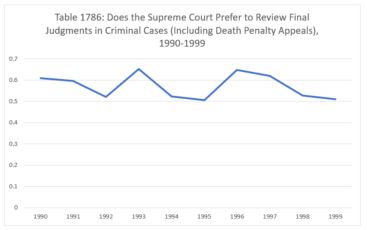- with readers working within the Retail & Leisure industries
This time, we're reviewing the share of appeals accounted for by final judgments in the 1990s. As a reminder, we're defining "criminal" broadly to include quasi-criminal cases such as habeas corpus, as well as juvenile justice cases. Until 2011 when Illinois abolished the death penalty, we also include direct appeals to the Supreme Court from death penalties in the trial courts.
During this decade, the percentage of cases which were either final judgments from the Appellate Court or death penalty appeals was fairly stable. In 1990, 60.87% of criminal appeals were either one or the other. In 1991, it was almost the same – 59.65%. The share rose to 65.12% in 1993 before falling into the low fifties, and then back to 64.81% in 1996. By 1999, it was back down to 50.94%.

Join us back here next week as we review the data for the decade 2000 to 2009.
The content of this article is intended to provide a general guide to the subject matter. Specialist advice should be sought about your specific circumstances.
[View Source]
